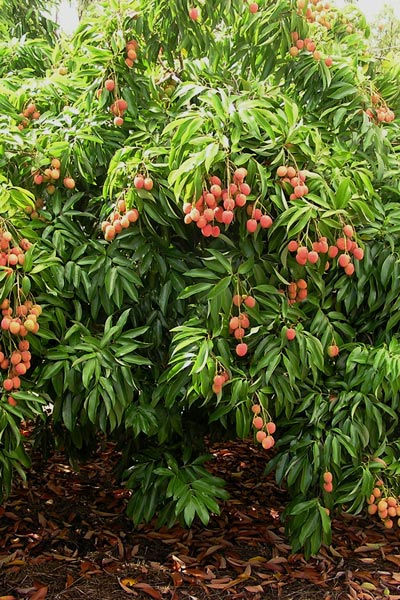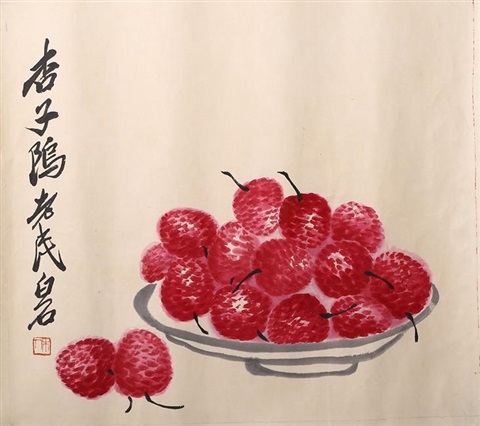Luck, romance and lychees, rambutan, longans and mangosteens
- rosemarydearman1
- Jan 17, 2018
- 7 min read

"Peeling away the lychee's thin brittle "shell" reveals the smooth, white, translucent flesh, which is sweet, but has a delicate flavour. Silky yet firm, a perfectly ripe lychee bursts with juice under the tooth." Gourmet Traveller
My inspiration today is the new edition of the Woolworths magazine - just to show I'm not biased in favour of one supermarket or another. Their featured 'in season' item was lychees, complete with a photograph of their grower - in the singular. Do they only have one? Further exploration on the net showed that there are in fact several growers in the tropical north, from the north of NSW to the Northern Territory. It's now quite an industry. Which means that Australia benefits from a long season from November to April.

It's a long-term investment for the farmers though as the trees take around ten years to grow and bear fruit. Nevertheless it would seem to be a viable alternative to the sugar which is not as thriving an industry as it once was. The Woolworths article had a rather lovely photograph of the unripe fruit. And the trees may take some time to grow but they do seem to produce a lot of fruit.

Apparently the Europeans mostly get theirs from Madagascar where it is an extremely important export crop. And then, most of Asia grows it for themselves. For, yes, it does come from China where it's cultivation dates back to the 11th century. News of it was taken back to Europe in 1695 by a Jesuit priest who drew this portrait of the tree and the fruit:

Here in Australia it was first grown by Chinese gold diggers in the 1870s, some of whose descendants still grow them today. The current day lychee and mandarin growing industries owe their existence to these early pioneers. And doubtless many other agricultural industries too.
The Chinese consider them lucky and romantic. The dried forms of lychees and longans are put under the marriage bed to encourage fertility, and lychees are often offered as a good luck charm at the New Year. The romantic aspect is shown in the many beautiful paintings I found. One at the top of the page and a couple more here. I just couldn't resist them.
Jane Grigson tells the story of the last T'ang Dynasty Emperor "who had them brought by a guard mounted on relays of fast horses, and told to make the journey from Ch'ang-an the capital to Canton, where the best lychees grew, in five days there and back" - a distance of 600 miles as the crow flies. So no doubt considerably more by road. For they need to be eaten fresh. As soon as they are picked they begin to deteriorate.
"The lichee's colour is altered in one day, its aroma in two, and that colour, aroma and taste are all lost in four or five." Po Chü-i - Chinese poet of 1st century AD
And they do not take kindly to canning either, although you can buy them canned. The flavour is delicate and therefore lost. The Australian body for the lychee growers is looking into ways in which the fruit can be used in a value-added way. Maybe you can get them frozen. Most of the writers I found seemed to think that simple was best"
"While I love the sweetness and fragrance of lychees, it's their exquisite silky texture I find most enjoyable. Pair them with something simple such as ice-cream (ideally, for me, my freshly made coconut ice-cream) to really appreciate them at their finest." Gourmet Traveller
However, if you want to do something with them there are plenty of suggestions out there. The SBS website had a pretty good range, from salads, to drinks, ice-creams and as additions to curries. Apart from these obvious things the other two things that seemed to pop up most often was lychees stuffed with cream cheese and then either served just as they were or deep fried (Woolworths magazine). I gather it's a thing in Hawaii. The other common thing was a cheesecake - and both Woolworths and SBS have one of these.
Cocktails seem to be a big thing. Try the Ping Pong from Longrain:
"It goes something like this: lychees with lime juice, passionfruit, lychee liqueur, lemon-infused vodka and ice. Cooling and delicious." Gourmet Traveller
Well first find your lychee liqueur - or make it yourself. With vodka perhaps.
Or you can be truly gourmet and out there and try Andrew McConnell's "gorgeous dessert of fresh lychees, coconut tapioca with a hint of ras el hanout spice, coconut sorbet, aloe vera, and fresh ginger granita." Gourmet Traveller
But the lychee is not alone. There are also rambutan, longan and mangosteen.
The rambutan is a larger version of the lychee but with prickles. The longan is yellow and the mangosteen is smooth and dark on the outside with five segments inside.
"No jewel was every more beautifully set than the mangosteen, with its pearly white fruit, in five fat segments, enclosed in a pith of a deep and lively pink. In a while, the pink darkens in contact with the air. You must break it away and eat the delicious fruit quickly." Jane Grigson
It's actually a long time since I have eaten a lychee, but yes it is rather lovely. I once had a rambutan straight from the market in Malaysia on a local excursion into town from Club Med. And yes, the Gourmet Traveller writer is right - it's the texture and the very delicate, faintly perfumed taste. There is nothing else quite like it - well quite like these four different but similar fruits. They're not cheap though. Woolworths is selling them for $17.90 a kilo.
Speedy seems to be the thing. Maybe grow your own? If you live in the tropics that is. But then you would probably have so many you wouldn't know what to do with them. Oh and I almost forgot. Don't give a lot to your children. They can be poisonous - seriously poisonous - although it seems this only applies to malnourished children. I'm sorry I didn't understand the science. But giving lots of lychees, particularly unripe ones to malnourished children has been known to kill them at a rate of 44%.
POSTSCRIPT
My friend in Kuala Lumpur sent me the following information about these things from his experience there. By the way he had previously pointed out (quite correctly that the 'spines' on the rambutans are hairs and not at all prickly.
"I'm not much on cooking but I have tried all the fruits you refer to in your blog. Strangely, I have never eaten 'fresh' lychees in the 20yrs I have lived in Malaysia. The last time I can recall having a 'fresh' lychees was in UK some 50yrs ago. I suppose it could hardly be classed as fresh by the time it got to UK, but we can let that pass. So I asked my wife whether we have lychees in Malaysia and if so why we never have them. She said "of course we have lychees in Malaysia but I never buy them because they are so expensive (A$20/kg here, similar to your prices) and longans are just as nice and a third of the price". Interestingly, we often have tinned lychees. I find them quite pleasant. They are commonly served as a cold drink: lychee ice. Three or four fruits are put in a glass and covered in their syrup and water and then finished off with a lot of ice. They are also served as a refreshing desert. A can of lychees and a can of sea coconut are tipped into a large bowl and then covered in ice. Individual portions are served by ladle.
Which brings me on to longans. We often have fresh longans. They come in two varieties here: longan and 'mata kuching'. Longans are about twice the size and twice the price of 'mata kuching'. I suspect that they are the same thing, they taste the same, its just the small longans are sold off cheaply (about A$3/kg). In Chinese longan is 'dragon's eye' because the white flesh surrounding the black stone resembles an 'eye'. 'Mata kuching' in Malay translates to 'cat's eye', its the same.
Rambutans come in two varieties here: red and yellow. The yellow ones are generally regarded as having better taste, though I wouldn't say there is a great difference. They grow on trees which get very big and fruit abundantly. As a consequence, in season. they are quite cheap (about A$3/kg). As I said they have a hairy covering over a thick leathery shell. The way to open them is to hold the fruit between the fingers and thumbs of both hands and then twist in opposite directions so the shell splits into two pieces. Luckily the hairs on the outside of the fruit are quite soft so this isn't difficult. The fleshy fruit surrounds a single stone which usually stuck to the flesh, unlike the lychee and the longan where the stone comes out easily.
Pulasan are sometimes referred to as rambutans, but they are different having a thick leathery shell closely set with thick fleshy straight spines. It could be that it is these that are referred to as rambutans in Australia. They are quite uncommon here and I have never tasted one. My wife says they are sweeter than rambutans and longans.
Mangosteens are another favourite and cost about the same as rambutan and so also fall within her budget.
In order of preference we would choose: durian (which is a whole different story), mangosteens, rambutan, longan but never lychees!
When tinned lychee are served as a desert I think it is mainly an ethnic Chinese Malaysian custom. My wife has picked it up from our Chinese friends. They are served with the ice in small ceramic bowls and eaten with a Chinese ceramic spoon."
Thanks so much for this - really, really interesting.

























Comments